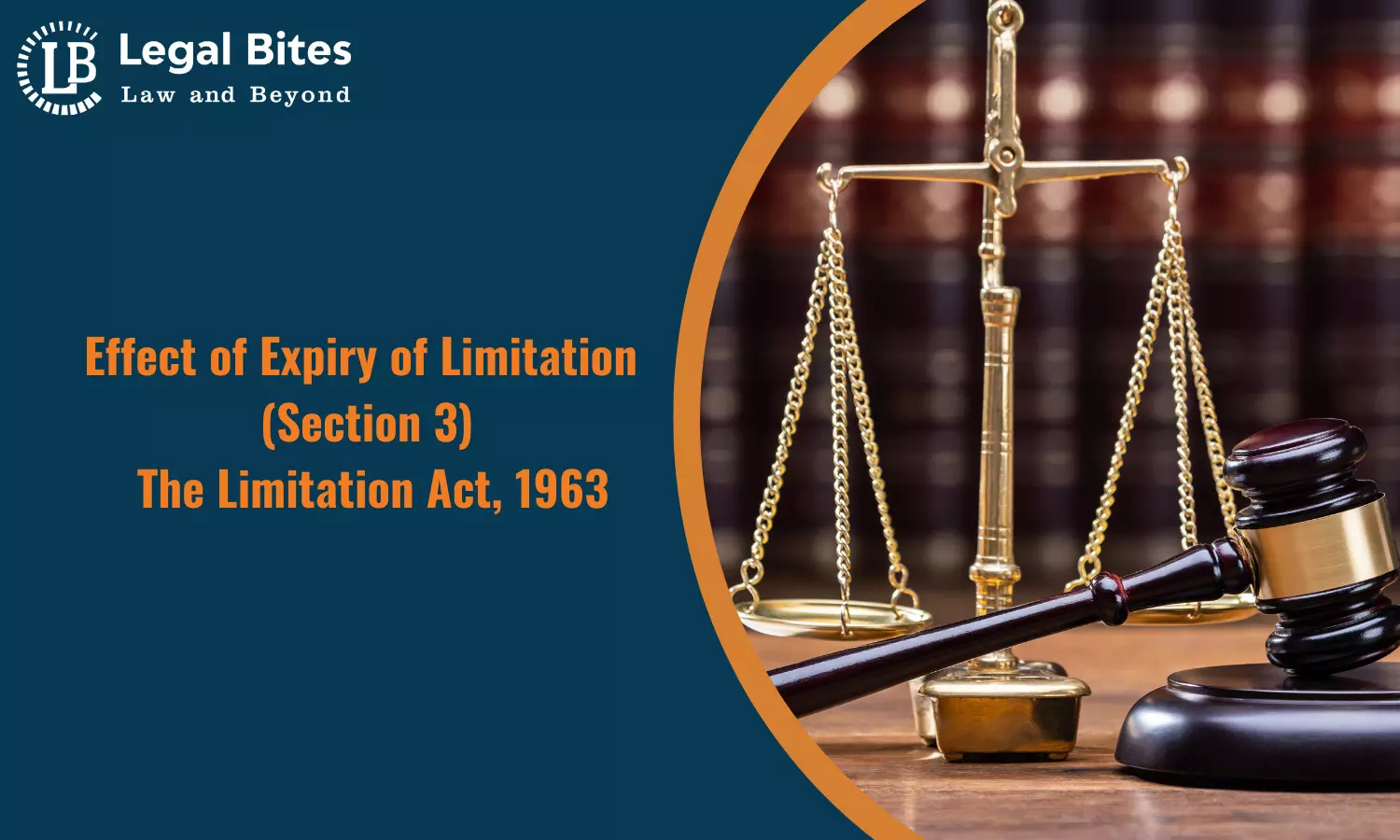Effect of Expiry of Limitation (Section 3) | The Limitation Act, 1963
The article 'Effect of Expiry of Limitation' delves into the pivotal legal concept of limitation periods as delineated in Section 3 of The Limitation Act, 1963 and the consequential impact of their expiration.

The article 'Effect of Expiry of Limitation' delves into the pivotal legal concept of limitation periods as delineated in Section 3 of The Limitation Act, 1963 and the consequential impact of their expiration.
Introduction
The maxim “Interest Reipublicae Ut Sit Finis Litium” encompasses the whole subject matter of limitation law. This maxim means that in the interest of the general public at large there must be a limitation set to the ‘right to litigate’ that is granted to all. Another maxim that holds the essence of limitation law is “vigilantibus non dormientibus Jura subveniunt” which means that while the law must support the ones who fight for their right, however, the ones who sleep on it shall not be supported by law. Thus, in this pretext, the Limitation Act, 1963 was enforced to maintain a time within which a person who is thereby aggrieved, can file a suit, appeal or application. The Limitation Act is exhaustive as regards the matters stated in it which means that there cannot be any extension granted by way of analogy.
Since it has been mentioned above that there is a prescribed period for filing a suit, appeal or application, Section 3 of the Limitation Act, 1963 becomes crucial. It is so because Section 3 of the Act mentions the ‘bar of limitation’. As per the section, any suit, appeal or application for it to be proceeded in the court, must be filed within the limitation period. If it is filed beyond the said period then the court shall be dutybound to not proceed with such cases regardless of whether the defence has raised a plea of limitation or not
Dismissal
The provision of Section 3 of the Limitation Act, 1963 which prescribes a bar of limitation is mandatory. The court is therefore under an obligation to dismiss any suit, application or appeal that has been filed beyond the period of limitation. It is imperative to note that such dismissal is not interdependent on the raising of issues regarding the limitation period.
Another facet of Section 3 of the Limitation Act, 1963 that is important to be noted is that the law of limitation merely bars the remedy by imposing a restriction on filing of the suit, appeal or application upon expiry of the limitation period. It does not, in any way, extinguish the right altogether. This enunciates how merely the judicial remedy is barred by Section 3 of the Limitation Act, 1963. The actual right upon which the said suit, appeal or application was based is not extinguished by this section or any other provision of the Limitation Act, 1963. It can also be inferred that while the Limitation Act, of 1963 is responsible for prescribing the period of limitation within which legal proceedings have to be initiated, it is not empowered to restrict any period for setting up defences for such actions. This reiterates that no right to original suit is barred by the said legislation.
Section 3(2) provides when a suit is considered to be instituted in different scenarios: in an ordinary case, when the plaintiff presents the plaint, in the case of a pauper when he applies for permission to sue without paying court fees, and the case of a claim against a company which is being wound up by the court when the claimant submits their claim to the official liquidator. Additionally, it specifies how claims by way of set-off or counterclaim are treated as separate suits and when they are deemed to have been instituted.
Furthermore, it mentions the timelines for initiating applications by notice of motion in a High Court, stating that such an application is considered made when it is presented to the proper officer of that court.
However, there are exceptions and provisions (mentioned in Sections 4 to 24) that can allow for a case to proceed even if the time limit has expired. These sections might include circumstances where the limitation period can be extended due to certain reasons such as fraud, disability, acknowledgement of debt, etc. These exceptions are implemented to ensure fairness in situations where enforcing the strict time limit would be unjust.
Important Cases
(i) R.B. Policies at Lloyd’s v. Butler, (1949) 2 All ER 226
This case is imperative to understand the interplay between property rights and the law of limitation. The case pertains to the issue of a motor car being stolen. The said motor car was then found with an innocent purchaser who was not aware of the car being stolen property. The legal question, in this case, was that since more than six years had now passed since the car had been stolen, which is the limitation period for filing suits, would it be viable to proceed with the said case?
The court determined that if a cause of action had to be accrued, there must be a party to sue and a party capable of being sued. Thus, the court held that since the car had been stolen more than 6 years ago there would be no suit. The law of limitation was adhered to to protect innocent parties from demands which do not hold validity.
(ii) Union of India v. West Coast Paper Mills Ltd., AIR 2004 SC 1596
This case involved a dispute between a government company and a private company. The case is also important as it involves intricate legal interpretation and a balance between judicial discretion and statutory provision.
The case was about the freight charges that had been levied by the Indian Railways. There was a dispute and, in its furtherance, West Coast Paper Mills Ltd. challenged the rates that had thus been revised. They contended that the revision was discriminatory and unjust. Railway Rates Tribunal declared the said rates to be unreasonable. After this, a subsequent leave petition was filed in the Supreme Court which was dismissed but the issue of the limitation period being exhausted for filing of suits for refund of the excess amount charged by the Railways was still pending.
The Supreme Court stated that post granting of special leave, the correctness and accuracy of the Tribunal’s order come into review. The court further enunciated that appeal is a mere continuation of a suit itself, and thus a decree shall only become applicable when the Court of Appeal disposes it. Thus, the suits which were filed by West Coast Paper Mills were held to be within the limitation period.
(iii) Punjab National Bank v. Surendra Prasad Sinha, AIR 1992 SC 1815
This case pertains to the loan that was granted to a person and guaranteed further by the respondent and his wife by issuing a security bond, which became guarantors of the said loan taken by the person. There was then a subsequent default by the principal debtor and upon maturing of the FD (fixed deposit) of the respondent (guarantor), the Bank manager adjusted the sum payable by the principal debtor and credited the remaining money in the respondent’s account.
The respondent filed a private complaint against the appellant alleging that since the limitation period for claiming the debt had ended, it was illegal to adjust the money from his matured FD. He stated that since his liability is co-extensive with that of the principal debtor, he was not liable to pay the loan money.
The court in this case stated:
“The rules of limitation are not meant to destroy the rights of the parties.”
It was in this case, that the court also reiterated that Section 3 does not destroy the right which grants remedy. The court stated that while the judicial remedy has been barred, the right to debt has not ipso facto expired. Meaning to say, the time-barred debt shall not cease to exist by Section 3. There shall exist the right to claim the money in any other manner except for filing a suit. The only right extinguished is the right to enforce the liability by filing a suit.
Conclusion
As understood by the above comprehension of Limitation Act, 1963, especially in the light of Section 3 which governs the bar of limitation to be imposed on filing of suit, it can be stated that the legislation plays a pivotal role in barring the right of litigation from being dragged over a long period. However, there are also logical exceptions including a certain degree of judicial discretion inserted via the provisions to leave space for any unforeseen circumstances that may arise.
References
[1] Anshu Singh Rathore, Applicability of the Statute of Limitation to Arbitration Proceedings: A Comprehensive Analysis, Available Here
[2] Sachi Ashok Bhiwgade, Salient Features of Limitation Act, 1963, Available Here
[3] The Limitation Act, 1963, Available Here

